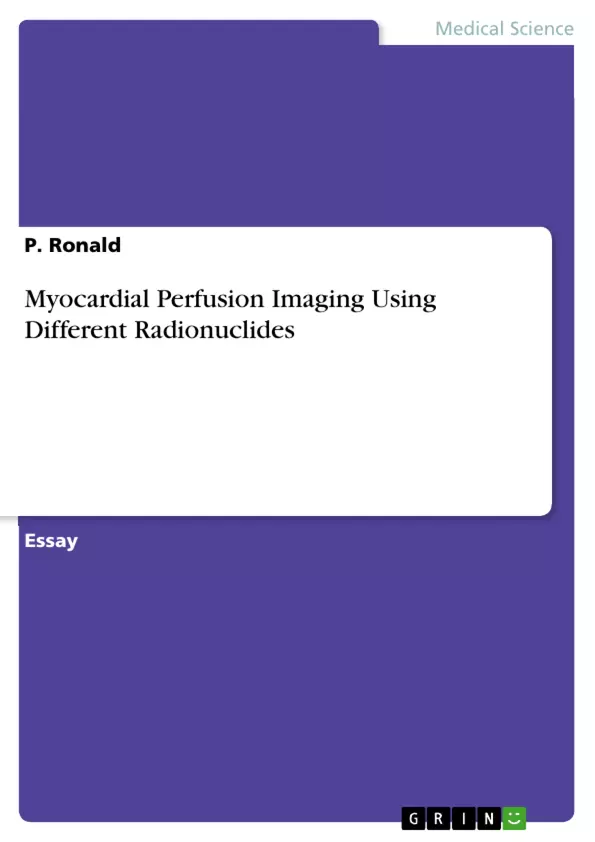Myocardial perfusion imaging specifically requires the use of radionuclides as tracers which are taken up and held on to by the cardiac muscles. The end result of the uptake of radioactive tracers is a three dimensional objective image which is quantifiable as it shows the intensity of tracer uptake within the myocardium (atrial or ventricular). The intensity of the tracer at any point on the image directly implies either blood flow sufficiency (perfusion) to that portion of the myocardium; of the ratio of live myocardium to fibrosed regions; or both. On this image, regions of ischemia or infarction appear as “cold spots”. In actual practice, the tracer intensity or concentration on the image is normalised to a normal myocardial region, that is, the region that shows the most radiotracer uptake. Therefore, the myocardial perfusion image can be said to be an image of relative perfusion of the myocardium.
Inhaltsverzeichnis (Table of Contents)
- Myocardial Perfusion Imaging by using Different Radionuclides
- Introduction
- Radionuclides
- Myocardial Perfusion Imaging
- Radionuclide Imaging
- Positron Emission Tomography (PET)
- Single Photon Emission Computed Tomography (SPECT)
- Image Quality and Resolution
- Conclusion
Zielsetzung und Themenschwerpunkte (Objectives and Key Themes)
This text aims to provide a comprehensive overview of myocardial perfusion imaging using different radionuclides. It delves into the historical context of nuclear medicine, the types of radionuclides used, and the technical aspects of both Positron Emission Tomography (PET) and Single Photon Emission Computed Tomography (SPECT) imaging. The text further explores the impact of radionuclide properties on image quality, highlighting key factors like attenuation, scatter, and spatial resolution.
- The history and development of nuclear medicine
- The properties and applications of radionuclides in medicine
- The principles of myocardial perfusion imaging using PET and SPECT
- Factors influencing image quality in radionuclide imaging
- The advantages and limitations of radionuclide imaging for cardiac diagnosis
Zusammenfassung der Kapitel (Chapter Summaries)
- Myocardial Perfusion Imaging by using Different Radionuclides: Introduces the topic of myocardial perfusion imaging, emphasizing its role in nuclear medicine and the use of radionuclides as tracers.
- Introduction: Provides a brief overview of the history of nuclear medicine and the development of radionuclide imaging.
- Radionuclides: Discusses the different types of radionuclides, their properties, and their production methods. It also highlights the specific radionuclides used in diagnostic and therapeutic medicine.
- Myocardial Perfusion Imaging: Explains the principle of myocardial perfusion imaging, focusing on the uptake and distribution of radioactive tracers within the heart muscle.
- Radionuclide Imaging: Introduces the two main techniques of radionuclide imaging: PET and SPECT. It explains their respective principles and how they are used in cardiac diagnosis.
- Positron Emission Tomography (PET): Delves into the specifics of PET imaging, including the production of positrons, the detection process, and the role of specialized equipment.
- Single Photon Emission Computed Tomography (SPECT): Provides a detailed explanation of SPECT imaging, comparing and contrasting it with PET. It highlights the use of collimators and the importance of specialized equipment.
- Image Quality and Resolution: Examines the factors influencing the quality of images produced by PET and SPECT, including attenuation, scatter, spatial resolution, and radioactive decay time.
Schlüsselwörter (Keywords)
Myocardial perfusion imaging, radionuclides, nuclear medicine, Positron Emission Tomography (PET), Single Photon Emission Computed Tomography (SPECT), image quality, attenuation, scatter, spatial resolution, radioactive decay time, diagnostic medicine, cardiac diagnosis.
- Citation du texte
- Dr P. Ronald (Auteur), 2010, Myocardial Perfusion Imaging Using Different Radionuclides, Munich, GRIN Verlag, https://www.grin.com/document/368310



